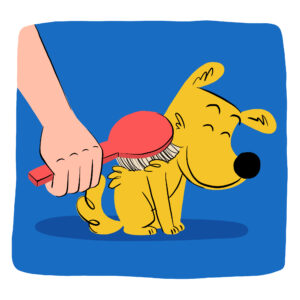Pets and Their People Blog
Help Your Pet Enjoy (not just tolerate) Brushing and Nail Trims!
You can help your pet enjoy basic care, such as brushing and nail trims, at home. Here are our tips so that some common husbandry procedures can be pleasurable for everyone involved.
Cooperative care and basic home pet care activities that help to keep pets healthy like grooming, bathing and nail clips have come a long way from the days of just ‘getting on with it.’ We now give our pets much more control and choice over these procedures so that they find them enjoyable.
Brushing Your Pet
Brushing your pet not only gets rid of tangles and knots, but even on short-haired breeds that shed, it’s a good thing to do as it encourages blood flow to the skin, and distributes oils through their coat, keeping them looking and feeling healthier.
How to help your pet enjoy being brushed:
- Choose the right brush. Long-haired cats and dogs will likely need a comb and slicker to help get through little knots, whereas short-haired breeds will find a rubber slicker, grooming brush or even a child’s soft hairbrush more comfortable.
- Start off easy. Puppies or kittens , and those who are new to being brushed, especially need a gentle introduction to more heavy-duty detangling brushes, so start off with a child’s soft hair brush or slicker brush for them.
- Use a ‘choice mat.’ Having a dedicated station, like a piece of vet bedding or mat on the floor where you groom your pet, gives them a choice to walk away when they’ve had enough. Research shows giving pets a choice over these procedures encourages more interaction, not less.
- Use treats. Food is great for changing emotional response, and building positive associations to procedures.
- Use feeders. Stuff up a KONG or use a LickiMat® stuck to the floor so your pet has something to do while you brush them. Holding a KONG in your hand that your pet can focus on while you brush them gently can work well.
- Preen little and often. Brush them for a minute or two at a time and then take a break, coming back to it later. This is also a great time to see if they want to come back to their grooming mat.
- Consider a conditioning spray. If you have a long-haired pet that has tangles, then a conditioning spray can really help to get through knots. Many pets don’t like being sprayed, so try using it on your hands and then running it through their coat, avoiding leaving it on the skin.
- Speak to a groomer or vet . If you have a severely matted pet, then assistance from a groomer, or a sedated groom, can help to get the worst out of the way, and then you can start fresh without your pet being worried.
How to Have Kind and Gentle Nail Trims
Most pets need their nails trimmed. Even if your dog walks on concrete, it likely won’t file their claws down enough, and long nails can cause health problems and pain for them. Indoor-only cats don’t get the opportunity to scratch on trees and sharpen their nails, reducing the length at the same time, so they also commonly need to have regular nail trims.
Here are our tips to teach your pet that nail trims are A-OK.
- Start early. It’s much easier to teach a puppy or kitten husbandry exercises than older pets who may have had bad experiences already.
Grooming, bathing and nail clips have come a long way from the days of just ‘getting on with it.’ ©Zigzag - Choose the right nail clipper. While some cats and small dogs are ok with a reasonably small nail clipper (you can even use human nail clippers if their claws are thin enough), medium and large dogs will have thick claws and will need a heavier duty nail clipper.
- Explore other tools. Rotary trimmers and scratch boards can also be used. Rotary trimmers need some work for your pet to get used to the sound and feeling but can work really well and can help you to avoid hitting the quick (see below). Scratch boards are boards covered in sandpaper. You’ll just need to teach your pet how to use the scratch board – ‘wipe your paws’ is a great trick to get them used to this option.
- Change the association. For dogs who are uncomfortable with nail trims, or unfamiliar with the process, show them the clippers and then give them a treat. Repeat this several times a day before you go near them with the clippers.
- Pick a paw. With your pet in front of you (maybe even on a choice mat – see above!) gently touch your pet’s paw with the clippers and then give them a treat. Do this sequence on all the claws on that paw, giving them a treat after each one, and then take a break. Try again with the next paw later that day. Repeat for several days so your dog or cat is getting used to this game being a fun thing to do .
- Time to start clipping. How your dog or cat reacts to this step will vary depending on how they feel about the nail trim. For some you’ll just need to do one claw at a time, whereas others will be comfortable with one paw, and others the whole shebang!
- Reward frequently. Whether your pet is totally OK with you doing all four paws of claws or not, reward them frequently while nail trimming so that they find the whole experience rewarding and pleasurable.
- Watch the quick. The quick is a small vein which runs down the inside of your pet’s claw. If their claws are white, you’ll be able to see this feature easily, but it’s not so easy to spot on a brown or black claw, so just nick the ends (sharp, pointy part) of the nails off, not too short. Over time, regular nail trims will help the quick to recede and make life easier.
- Practice regularly. The more often you do this claw maintenance with your pet, the easier nail trims will be in the future. Take some time now and go at your dog or cat’s pace.
We hope the methods above have given you some ideas; there are quite a few different methods for cooperative care exercises so that your dog likes nail trims, being brushed and being bathed.
Remember not to rush the process, to take the time to teach your pets, and to be patient so that they don’t feel overwhelmed or worried.
If your dog or cat has had negative experiences in the past, or is very sensitive to being handled, it can be useful to get some help with grooming and nail trims from a professional . They can help you put a structured plan together so that over the long term, your pet has good experiences, with care procedures – and with you!
About the Author
Petrina Firth is a Dog Trainer and Certified Animal Behaviorist of over 10 years who now mainly specializes in Separation Anxiety (CSAT) and also creates content, lessons and articles for the Zigzag puppy training app and website. Petrina is a member of the Pet Professional Guild, the head of marketing and board member for the APDT UK, and a member of the CAPBT committee. She is also a tech and gadget enthusiast who enjoys city living with her rescue French Bulldog and partner.

Zigzag is a Pet Professional Guild Corporate Partner.


